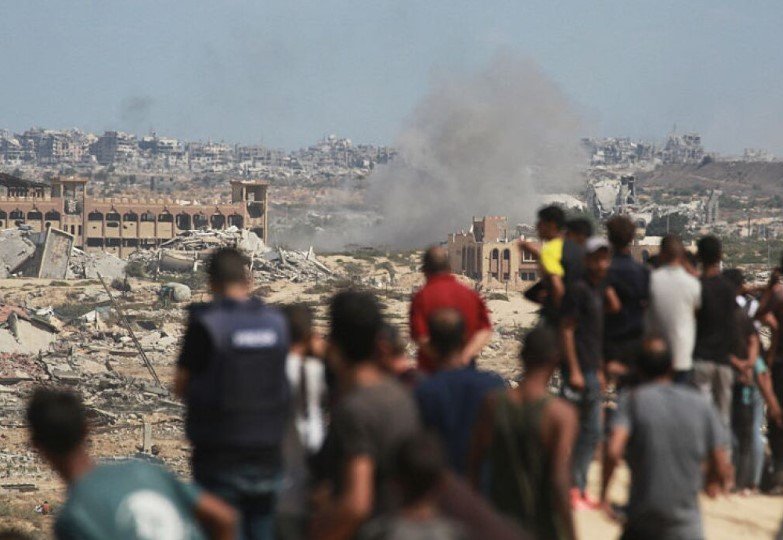In a bold move shaping Middle East dynamics, US President Donald Trump visited Israel’s Knesset on October 13, 2025, declaring that Israel has won its fight against Hamas and urging a shift toward lasting peace. This comes as Prime Minister Benjamin Netanyahu insists on complete victory, including disarming Hamas, highlighting tensions between military goals and diplomatic pressures after over two years of conflict.
Trump’s Vision for Middle East Peace
President Trump outlined a 20-point peace plan that has gained traction, leading to a fragile ceasefire announced in early October 2025. The plan calls for hostage releases, Hamas disarmament, and rebuilding Gaza under international oversight. Experts say this framework draws from past efforts like the Abraham Accords, expanded to include more Arab states.
Recent reports show the first phase of the plan has seen some success, with hostages freed and a temporary halt in fighting. Trump praised the deal during his Knesset speech, stating Israel should now focus on prosperity rather than endless war. However, challenges remain as both sides navigate trust issues built over years of hostility.

The plan also involves key players like Egypt, Qatar, and Turkey in mediation. Analysts note that Trump’s approach balances support for Israel with pressure on Hamas, aiming to prevent a wider regional crisis.
Netanyahu’s Push for Total Victory
Prime Minister Netanyahu has repeatedly stressed that victory means nothing less than Hamas’s full surrender and disarmament. In speeches following Trump’s visit, he described two paths: peaceful handover of weapons or forceful action if needed. This stance reflects Israel’s goal since the war began on October 7, 2023, when Hamas attacks killed around 1,200 people and took 251 hostages.
Despite heavy military operations, Hamas still controls parts of Gaza and shows resilience. Israeli officials claim major blows to Hamas infrastructure, but critics argue true victory requires regime change and limits on rebuilding military strength.
Netanyahu’s team points to recent gains, including targeted strikes that weakened Hamas leadership. Yet, the group continues to negotiate as a legitimate party, complicating Israel’s aims.
Public opinion in Israel remains divided, with some supporting ongoing operations while others call for peace to end the humanitarian toll.
Hamas’s Resilience and Ongoing Challenges
Hamas has endured significant losses but refuses unconditional surrender. Leaders have signaled willingness to discuss ceasefire terms, but they reject full disarmament without concessions like Palestinian statehood talks.
The group’s control over Gaza areas allows it to influence aid distribution and civilian life, even amid destruction. International observers estimate thousands of fighters remain active, using tunnels and urban tactics to evade Israeli forces.
- Heavy civilian casualties: Over 40,000 reported deaths in Gaza since 2023, sparking global protests.
- Economic impact: Gaza’s infrastructure is in ruins, with rebuilding costs projected at billions.
- Regional spillover: Conflicts with Hezbollah and Houthi groups have escalated, drawing in more nations.
These factors make a quick resolution tough, as Hamas leverages its survival for leverage in talks.
US Role and International Pressure
The United States under Trump has played a pivotal role, providing military aid to Israel while brokering the peace deal. Trump’s administration lifted some arms restrictions, bolstering Israel’s position, but also pushed for diplomacy to avoid prolonged war.
Allies like Saudi Arabia and the UAE have joined efforts, potentially normalizing ties with Israel in exchange for Gaza stability. This aligns with Trump’s promise of a “new Middle East” focused on economic growth.
However, tensions arise as the US urges restraint to enable peace. Experts warn that forcing disarmament could restart fighting, testing the fragile truce.
A key element is the proposed international force to stabilize Gaza, including Arab nations overseeing governance. This could sideline Hamas but raises questions about long-term control.
The Path Forward: Peace or Prolonged Conflict?
As the ceasefire holds into November 2025, both sides face critical decisions. Israel weighs military action against diplomatic gains, while Hamas navigates survival amid isolation.
Recent events, like the release of 20 Israeli hostages for 250 Palestinian prisoners, show progress but highlight fragility. Analysts predict the next phase, focusing on disarmament, will define success.
| Aspect | Israel’s Position | Hamas’s Position | Trump’s Plan |
|---|---|---|---|
| Disarmament | Demands full surrender of weapons | Resists without statehood guarantees | Calls for voluntary or forced steps |
| Governance | Seeks Hamas removal from power | Wants role in post-war Gaza | Proposes Arab-led administration |
| Hostages | Prioritizes full release | Uses as bargaining chip | Includes phased exchanges |
| Rebuilding | Supports under strict controls | Demands open aid access | Ties to international oversight |
The coming months could reshape the region, with potential for enduring peace or renewed violence.
What do you think about Trump’s peace efforts in the Middle East? Share your views in the comments and spread the word to keep the conversation going.
